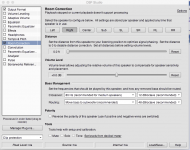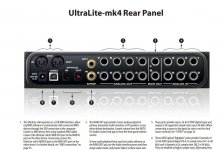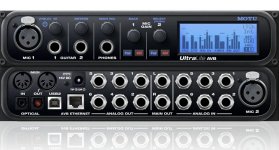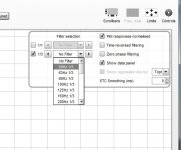Indeed it was only to show this stuff works as expected. I get that you're stuck in the way of straightening a driver and then use a named crossover. I don't feel the same need to do things that way. As a FIR filter can resolve it just as easily and can even resolve the timing issue.
If one would have to use timing and not wanting to solve it with FIR, there's always plugins that do just that. The free Voxengo sound delay plugin comes to mind, but there will probably be others as well that can delay in samples just like this free one. Stick it in something like Metaplugin and you can use it on all channels you'd like, each with their own settings.
There's always more than one way really. I'm pretty sure if you search for it there will probably be a Bessel solution in a plugin somewhere. As said before, JRiver can function as a host housing pretty much all you can ever wish for. With 'sub level' hosts like Metaplugin you can build pretty crazy stuff.
Nope, if you think I'm stuck on the 'way of straightening a driver and then use a named crossover', I don't think you're really understanding what I' m stuck on. 🙂
It has nothing to do with using named xovers.
It's about using complementary xovers.
And so far, I've yet to meet an un-named xover that is complementary. 😉
Whatever you do in FIR, even if it's just a straightforward impulse inversion, once it is crossed over with any topology "named" or "un-named" xover, it becomes the multiplication of the two.
And the final correction filter will not be not be able to be identified by any specific type or order.
So calling the final correction a product of a using a named or un-named xover ends up being pure semantics imo.
The same is true if you stay in the IIR domain, flatten first, and then use complementary xover. Result is un-named...how you got there is just more semantics....
I really like JRiver, but in fairness, let's be honest about its strengths and weaknesses.
Imo, it is fairly weak as a multi-way loudspeaker management platform without going full FIR....or on its own without an unknown set of plugins.
I, like many i suspect, simply don't want or care to incorporate plugins....or use a PC at all really, for speaker processing.
And imho with regards to REW,... it has become ridiculously complicated in terms of accommodating time and phase alignment. (The earlier versions were better than today's V5.20 Beta 39 in this regard, imo.)
I ask that you let go of my take on JRiver or my method for phase alignment, and please show me how to get REW to do the most simple of phase alignments without diving into 1/3 octave bandwidth filter impulses.
Like I was lamenting in my previous post.....align WHAT and HOW?
I understand alignment theory, but get more confused how REW works the deeper i dig....
And with real measurements, straight electrical works fine. Just no computer generated impulse imports, pls. I can get those to work fine.
maybe/hopefully I'm just missing something stupid...thx..
Do you mean the Room Correction settings within JRiver?
Where you put in actual distance to each speaker?
This would help to make an asymmetric speaker position sound more symmetric. However I haven't used it once.
As I've setup everything equal distance and where I couldn't I just put in delay where needed (like on ambience channels).
Well, moving the distance sliders would change the delay, but it would be guess work.
I was mentioning it mostly because of the different XO curves you can try quickly from there, plus adjust individual levels and phase between them.
Attachments
I'd still like confirmation that the Ultra MK4 actually shows 8 output channels within JRiver. I get it that it's a Left, Right and channels 1 till 6 but I don't get that the 8A simply shows 8 channels analog out.
Prices over here are not that far apart if one holds more promise than the other. Even though I currently use 6 channels, really having 8 available is worth something. (for future experiments)
I'd need to convert balanced back to single ended for two amplifiers, but I am interested in one of these Motu devices.
Even if I'd get 3 Universal Buffers first, I'd still could go this route and use 2 of them later on on the amp side to do the balanced to single ended conversion with unity gain (1 volt in is 1 volt out).
So thank you both for bringing it to my attention. 🙂
I didn't have time to look it up in the manual, but, for most pro cards with multiple outs, usually the Mains R/L is duplicated on the outputs 1/2.
I really like JRiver, but in fairness, let's be honest about its strengths and weaknesses.
Imo, it is fairly weak as a multi-way loudspeaker management platform without going full FIR....or on its own without an unknown set of plugins.
I, like many i suspect, simply don't want or care to incorporate plugins....or use a PC at all really, for speaker processing.
If we are trying to be fair Jriver is a media player that happens to have a DSP engine that can be made to function as a multiway crossover. With creative use of Butterworth slopes and EQ almost any desired transfer function can be created without resorting to FIR convolution. This is not it's forte, the ways around that have been highlighted, if it doesn't work for you so be it. There are no better options as far as I am concerned as I have no issue with plugins but don't want a tap limited hardware device. Horses for courses 🙂
The point of the filtering is to make the matching easier and less hassle.I ask that you let go of my take on JRiver or my method for phase alignment, and please show me how to get REW to do the most simple of phase alignments without diving into 1/3 octave bandwidth filter impulses.
Like I was lamenting in my previous post.....align WHAT and HOW?
I understand alignment theory, but get more confused how REW works the deeper i dig....
And with real measurements, straight electrical works fine. Just no computer generated impulse imports, pls. I can get those to work fine.
maybe/hopefully I'm just missing something stupid...thx..
By filtering near the crossover frequency you can match the wave shapes together to get good alignment by seeing what each side is doing at that frequency.
Otherwise you are stuck trying to match impulses at the start or peak and then needing to recheck the step or frequency response to check it worked as expected. If you want to align phase traces you can do it that way too but not at the same time as twiddling the delay as the controls are in separate locations.
Generated impulses allow it to be clear what has happened when trying to demonstrate something, a flat line is easy to see. If it works for perfect impulse and not for real measurements something is wrong with the measurements or not set correctly elsewhere.
Nope, if you think I'm stuck on the 'way of straightening a driver and then use a named crossover', I don't think you're really understanding what I' m stuck on. 🙂
It has nothing to do with using named xovers.
It's about using complementary xovers.
And so far, I've yet to meet an un-named xover that is complementary. 😉
Whatever you do in FIR, even if it's just a straightforward impulse inversion, once it is crossed over with any topology "named" or "un-named" xover, it becomes the multiplication of the two.
And the final correction filter will not be not be able to be identified by any specific type or order.
So calling the final correction a product of a using a named or un-named xover ends up being pure semantics imo.
Happy to read that. Sure I'm aware that when crossing two drivers the sum will depend on energy from both of them which determines how the end result turns out. I've been playing with that for quite a while as you can use it to your advantage. Not only for crossovers but even more so for my crosstalk cancellation experiments.
We won't force you to do things different, I'm not attacking you here, I was basing that remark about named crossovers on things you said here and at other places.
Personally I've never looked at named crossover types that much simply because I focus on getting the output to confirm to whatever I need. I may use them at times, but it has never been a straight forward crossover in my case. As I like to make use of the driver's complimentary sum to make up for things I don't like out in my room.
The same is true if you stay in the IIR domain, flatten first, and then use complementary xover. Result is un-named...how you got there is just more semantics....
I'd call that good use of a named crossover. And the end result would be a "by the book" crossover as well. As the acoustic output follows textbook results at the measurement point.
Nothing wrong with that.
I really like JRiver, but in fairness, let's be honest about its strengths and weaknesses.
Imo, it is fairly weak as a multi-way loudspeaker management platform without going full FIR....or on its own without an unknown set of plugins.
I, like many i suspect, simply don't want or care to incorporate plugins....or use a PC at all really, for speaker processing.
I couldn't tell you liked JRiver, honestly 🙂. But you don't have to.
To each his own. See Fluid's comments. I've said it myself a couple of times too. It can house anything you'd ever want or need. It isn't even a full force speaker management system, but it can become that, and much more as you can build upon it. To me, the strength is having it work as a VST host.
As that makes it nearly unlimited in its uses. If it couldn't run VST plugins I'd never stuck with it, despite it having a convolution engine. But I'd stick to using a computer because I do like the freedom that it provides me.
As it turns out, JRiver does let me have that freedom to experiment with whatever I can come up with. Personally: I love it.

But that does not mean you have to like it too...😉
And imho with regards to REW,... it has become ridiculously complicated in terms of accommodating time and phase alignment. (The earlier versions were better than today's V5.20 Beta 39 in this regard, imo.)
I ask that you let go of my take on JRiver or my method for phase alignment, and please show me how to get REW to do the most simple of phase alignments without diving into 1/3 octave bandwidth filter impulses.
Like I was lamenting in my previous post.....align WHAT and HOW?
I understand alignment theory, but get more confused how REW works the deeper i dig....
And with real measurements, straight electrical works fine. Just no computer generated impulse imports, pls. I can get those to work fine.
maybe/hopefully I'm just missing something stupid...thx..
I sense a bit of frustration here, my posts were never aimed to do that. In fact I thought I was helping people to get an easier way to align crossovers where we take the guess work out of it.
I can't tell where it went wrong for you. I've been using this for quite a while and it never failed me. I did show a measurement and a virtual result to show that what's important can still be seen/identified. If that's not the case something must be wrong.
I have mentioned two methods I use. I'm not about to show you how I also look at phase traces within the overlay windows. I do know how you feel about REW and phase traces.
But why so unhappy? You've found good use of other programs to do the job, right? I'm not saying everyone should stick to REW or JRiver just because I do? I just show what I use, as it 'just might help others' with their results.
Last edited:
I didn't have time to look it up in the manual, but, for most pro cards with multiple outs, usually the Mains R/L is duplicated on the outputs 1/2.
That was what I was thinking. And it gets confusing, as the manual showed a different back side than the items for sale.
From the manual:
In an add showing the device:
Those two aren't the same... that's obvious. But which one is it then? Should it look like the one in the manual?
Edit: I finally found the exact one as pictured in the manual. I now get that I should look for the non AVB version (no network connector on the back).
But it seems hard to get over here... some say it is no longer available and other sites show an unknown delivery time.
As long as the handling of the DAC isn't known, compared to other options like the Ockto etc. I'm a little hesitant to go ahead on a hunch.
Even though it seems to be able to do all I could ever want with great measurements to boot and at a good price.
At least: the differences fluid mentioned as far as filtering on the DAC goes does not make me happy if we can't influence it, as
it seems obvious there are differences between the ways it can be done and not all options are good options. So if it's a you get what you
get and no options, we'll never know what it is we are going to get.

Attachments
Last edited:
Well, moving the distance sliders would change the delay, but it would be guess work.
I was mentioning it mostly because of the different XO curves you can try quickly from there, plus adjust individual levels and phase between them.
To me it seems quite limited and meant for basic use. Us nutcases go well beyond that initial use. This is more inline with what a standard AVR would give you as far as options go.
With a measurement suite and the tools we use we go way further in trying to control the eventual outcome. At least I know I do 😀.
Ha ha Mark, nice discussions there 🙂
Think there could be more trouble with digital time allignment be 100% on cycle in phase wheel especially the higher the frequency is, see below Klippel note 🙂
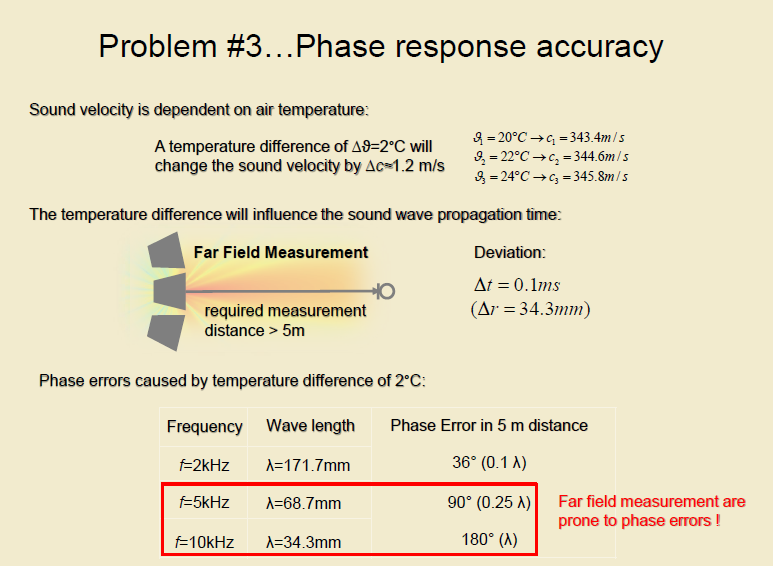
Hi BYRTT, yep...the prosound line array guys often bring this up.
Some loudspeaker management processors even have ambient temperature and humidity sensors, to help with beam steering. Check out EAW's Anya or Martin's MLA systems for some really cool tech.
Correct me if I'm wrong, but as I remember temp change as per the Kippel example causes a fixed delta t across frequency, or rather a constant change in excess delay.
So to get rid of any error, it seems all that is needed is to make a new measurement at the new temp....
And regardless of temp, I know in the case of my coax CD's sections, relative timing doesn't change with temp since the two sections radiate as a near point source.
Copy below numbers on a piece of note should help set 2nd order Bessel or 3rd order Butterworth textbook slopes in Jriver, they my own hobby homebrew but should be 100% okay 🙂
Bessel 2nd order have frequency number relation of 1,27 relative to filter Bessel target setting, that is below example using 1000Hz number will be a 1,27x1000Hz=1270Hz BES2 target, and should BES2 target be 1000Hz then set below filters to 1000/1,27=787,4Hz:
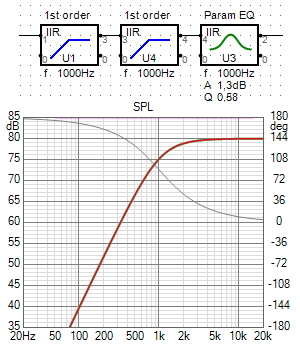
Butterworth 3rd order:
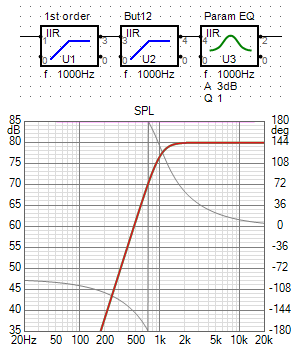
Thx, It's really cool you can do that ! 🙂
I've played with such too, but only for education, not for implementation.
I always look for and turn to, the most straight forward method of implementation..ie a BW3 in a menu list lol
If we are trying to be fair Jriver is a media player that happens to have a DSP engine that can be made to function as a multiway crossover. With creative use of Butterworth slopes and EQ almost any desired transfer function can be created without resorting to FIR convolution. This is not it's forte, the ways around that have been highlighted, if it doesn't work for you so be it. There are no better options as far as I am concerned as I have no issue with plugins but don't want a tap limited hardware device. Horses for courses 🙂
The point of the filtering is to make the matching easier and less hassle.
By filtering near the crossover frequency you can match the wave shapes together to get good alignment by seeing what each side is doing at that frequency.
Otherwise you are stuck trying to match impulses at the start or peak and then needing to recheck the step or frequency response to check it worked as expected. If you want to align phase traces you can do it that way too but not at the same time as twiddling the delay as the controls are in separate locations.
Generated impulses allow it to be clear what has happened when trying to demonstrate something, a flat line is easy to see. If it works for perfect impulse and not for real measurements something is wrong with the measurements or not set correctly elsewhere.
Yep, horses for courses works, and finding the right horse for the course is quite often the name of the game, imho. 🙂
Agreed on the problem of trying to match impulses peaks and starts, and twiddling controls in separate locations, to align phase.
I guess that's why I keep using dual channel, as it overcomes that problem with real time comparison capability.
I think maybe some of the difficulty I've been having with measurements vs imported impulse responses, and this is a guess....
.....is that the imports are from very clean ideal generations (rePhase, etc) and REW nails timing on imports at either our choice of t=0 at peak, or at first sample. Precise timing on an import where peak is predetermined.
Whereas on measurements, REW must build an impulse response from available captured data, and make estimations on timings.
A little slippage perhaps, compared to cleaner imports...???
That may very well be true, as the (exact) timing does influence how a phase trace will look.
Hello all.
I read the full thread (some 120 pages or so) Wesayso linked to. All in all it is interesting stuff, and it was a very "dynamic" discussion, but I did not really note anything new there. My thinking was constantly that people were confusing the amplifier headroom with the signal headroom. And I got a bit irritated when the discussion got heated. I might have lost concentration at around page 50.
But what you said, fluid, makes a lot of sense, as you said it. This is something I have noticed again and again in the past, but wrote it off as badly designed equipment (except, of course, for when it was something I was selling 🙂).
Most of us are very aware of the sound of "dynamics lacking", but I have never looked closely at the input-signal side of things, although I have been very aware of the fact that matching can be a pain.
I ought to have enough headroom in the power amplification side of things (depending of course on the type of music I listen to), but this makes me start to wonder about structuring the chain before that with these problems in mind.
Thank you both, sometimes it takes a few attempts at explaining before I can understand the point.
I read the full thread (some 120 pages or so) Wesayso linked to. All in all it is interesting stuff, and it was a very "dynamic" discussion, but I did not really note anything new there. My thinking was constantly that people were confusing the amplifier headroom with the signal headroom. And I got a bit irritated when the discussion got heated. I might have lost concentration at around page 50.
But what you said, fluid, makes a lot of sense, as you said it. This is something I have noticed again and again in the past, but wrote it off as badly designed equipment (except, of course, for when it was something I was selling 🙂).
Digitally reducing the input level to the DAC by 4dB fixes this in almost every conceivable situation. Some DAC's don't suffer from it like the latest Benchmark DAC's, a lot still do.
The second reason is that most DAC's do not perform at their best at 0dB, they are better behaved a few dB below, they measure better at that level.
Most of us are very aware of the sound of "dynamics lacking", but I have never looked closely at the input-signal side of things, although I have been very aware of the fact that matching can be a pain.
I ought to have enough headroom in the power amplification side of things (depending of course on the type of music I listen to), but this makes me start to wonder about structuring the chain before that with these problems in mind.
Thank you both, sometimes it takes a few attempts at explaining before I can understand the point.
The newer 9028 and 9038 have more and some of the manufacturers have rolled their own, a function which was always there with the older chips.
Yes, but the implementation in the older ones has a flaw which makes it unusable.
//
Hello all.
I read the full thread (some 120 pages or so) Wesayso linked to. All in all it is interesting stuff, and it was a very "dynamic" discussion, but I did not really note anything new there. My thinking was constantly that people were confusing the amplifier headroom with the signal headroom. And I got a bit irritated when the discussion got heated. I might have lost concentration at around page 50.
But what you said, fluid, makes a lot of sense, as you said it. This is something I have noticed again and again in the past, but wrote it off as badly designed equipment (except, of course, for when it was something I was selling 🙂).
Most of us are very aware of the sound of "dynamics lacking", but I have never looked closely at the input-signal side of things, although I have been very aware of the fact that matching can be a pain.
I ought to have enough headroom in the power amplification side of things (depending of course on the type of music I listen to), but this makes me start to wonder about structuring the chain before that with these problems in mind.
Thank you both, sometimes it takes a few attempts at explaining before I can understand the point.
I mainly pointed to the thread for Tom Danley's contributions. When he talks, I listen. Because most of the time he makes a lot of sense! 😀
I think guarding each step in our chain to be able to faithfully follow what's been going into it is important. That's where I've been lacking for a while.
While I was trying to solve that by finding better, cleaner results in my processing, the fault really wasn't on that side of the chain.
I wasn't looking for louder, I was looking for cleaner sound that I knew I have had before. I've been listening to the system with pré amp installed for weeks on end now and even though tonal balance isn't spot on yet, it has been a joy to listen to it. Because I do have the dynamic feel back. It may be quite true the M1 performs better a little further attenuated, as that's how I reached the conclusion something must be off if it sounds real sweet and convincing at lower levels and then simply falls short of that when played back louder.
While listening today I walked up to the speakers and never even saw the cones move. The amplifier barely gets warm. Yet the level is as high as it was before. Same goes for the subwoofers, I don't really see them move.
Yet the room is filled with sound, making up a believable stage and space.
In an effortless way... that's all the difference.

Happy to read that. Sure I'm aware that when crossing two drivers the sum will depend on energy from both of them which determines how the end result turns out. I've been playing with that for quite a while as you can use it to your advantage. Not only for crossovers but even more so for my crosstalk cancellation experiments.
We won't force you to do things different, I'm not attacking you here, I was basing that remark about named crossovers on things you said here and at other places.
Personally I've never looked at named crossover types that much simply because I focus on getting the output to confirm to whatever I need. I may use them at times, but it has never been a straight forward crossover in my case. As I like to make use of the driver's complimentary sum to make up for things I don't like out in my room.
I'd call that good use of a named crossover. And the end result would be a "by the book" crossover as well. As the acoustic output follows textbook results at the measurement point.
Nothing wrong with that.
I couldn't tell you liked JRiver, honestly 🙂. But you don't have to.
To each his own. See Fluid's comments. I've said it myself a couple of times too. It can house anything you'd ever want or need. It isn't even a full force speaker management system, but it can become that, and much more as you can build upon it. To me, the strength is having it work as a VST host.
As that makes it nearly unlimited in its uses. If it couldn't run VST plugins I'd never stuck with it, despite it having a convolution engine. But I'd stick to using a computer because I do like the freedom that it provides me.
As it turns out, JRiver does let me have that freedom to experiment with whatever I can come up with. Personally: I love it.
But that does not mean you have to like it too...😉
I sense a bit of frustration here, my posts were never aimed to do that. In fact I thought I was helping people to get an easier way to align crossovers where we take the guess work out of it.
I can't tell where it went wrong for you. I've been using this for quite a while and it never failed me. I did show a measurement and a virtual result to show that what's important can still be seen/identified. If that's not the case something must be wrong.
I have mentioned two methods I use. I'm not about to show you how I also look at phase traces within the overlay windows. I do know how you feel about REW and phase traces.
But why so unhappy? You've found good use of other programs to do the job, right? I'm not saying everyone should stick to REW or JRiver just because I do? I just show what I use, as it 'just might help others' with their results.
Thanks Wesayso, a kind reply, sensing my frustration 😱
I had spent nearly three hours trying every combination/permutation of measurement settings, alignment settings I could think of in REW, looking for some simple set of them that could handle the easiest of all summations, a LR xover in nearly the middle of the linear frequency spectrum, with no success.
Your 1/3 octave bandwidth filtered impulse method at xover was the only method that worked.
I keep wanting to get truly proficient with REW as it has expanded capabilities over dual channel FFTs (such as THD, etc), and it's the language spoke here on the forums. But the sheer degree of effort to make simple timings turns maddening. 4-ways demand a simple process I've found, or things get too error prone or difficult to experiment with.
Anyway, my problem...not fair to burden others with it...
And yes, I've long been a fan of JRiver. Got 3 ID's when they first came out, to host my music and to compare different speaker/room setups.
So not so unhappy, just a dumb old dude who wants things to work easy and gets frustrated when they don't haha.
Thanks again 🙂
Your 1/3 octave bandwidth filtered impulse method, will be workable also at say 50 Hz do you think?
//
//
Your 1/3 octave bandwidth filtered impulse method, will be workable also at say 50 Hz do you think?
//
Think method in itself should be excelent and allign close to 100% precise those filtered IR 🙂 that said to utilize that precision REW should be set up use a loopback channel or acoustic timing as reference else a subwoofer IR would be so woolly a signature that from sweep to sweep or relative to the other full range IR there will be variances where its alligned on timeline.
Last edited:
Edit: I finally found the exact one as pictured in the manual. I now get that I should look for the non AVB version (no network connector on the back).
But it seems hard to get over here... some say it is no longer available and other sites show an unknown delivery time.
As long as the handling of the DAC isn't known, compared to other options like the Ockto etc. I'm a little hesitant to go ahead on a hunch.
Even though it seems to be able to do all I could ever want with great measurements to boot and at a good price.
At least: the differences fluid mentioned as far as filtering on the DAC goes does not make me happy if we can't influence it, as
it seems obvious there are differences between the ways it can be done and not all options are good options. So if it's a you get what you
get and no options, we'll never know what it is we are going to get.
It is probably difficult to find the non AVB one now and I hadn't noticed the back panel connections myself, no coax either now.
I do understand your desire to be cautious as there is some difference between DAC's that tends to relate back to the chips used. I like the Sabre DAC's I find them cleaner. My cleaner might be your hard digital so that was why I offered to send you a DAC to test 🙂 I am happy to leave it exactly where it is though 😉
As to the filter selection if there is no choice then it is almost certain that linear phase fast is being used as that is the hardware default. To get anything else an i2c command has to be sent. To me that is the best option anyway. The filter can always be defeated by upsampling to a higher frequency and adding in your own anti aliasing filter to whatever recipe you desire but to avoid aliasing with 44k material a strong 20ish K filter is needed on everything.
Explains why no one ever used it 🙂Yes, but the implementation in the older ones has a flaw which makes it unusable.
//
- Home
- Loudspeakers
- Full Range
- The making of: The Two Towers (a 25 driver Full Range line array)
